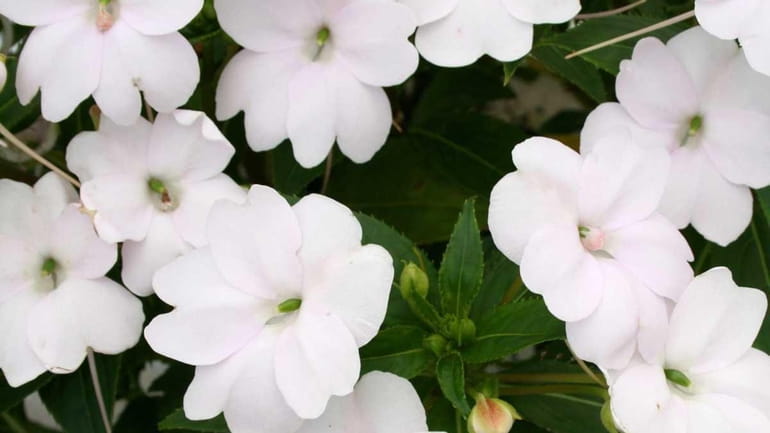A touch of calm in the garden

White impatiens provide a buffer. Credit: NEWSDAY/Handout
Reader Paula Ganzi Licata lives in Bellmore.
I wheel my cart through Long Island garden centers, my pupils dilating with pleasure, as I'm drawn to the most exhilarating shades, rushing from row to row, navigating narrow nursery aisles, dragging my cart over watering hoses snaking across the floor, worried that some other shopper will swipe the last of the magenta dahlias, fuchsia geraniums or fiery red New Guinea impatiens.
I'm a color junkie. I want rainbows in my flower beds.
If I see a shopper with a cart full of white flowers, I'm aghast. Where's the vibrancy? The intensity? The eye-catching, breath-stopping rush they get when they glance at their gardens?
When I first started gardening, I had distinct color schemes for each area: red impatiens in the front yard, purple petunias along the driveway border, and in the backyard perimeter, zinnias in fluorescent shades of hot pink, bright yellow and bold orange.
Then one year I discovered the joy of the mix: a haphazard, all shades in all beds. The color combinations seemingly burst out of the earth, like artists' palettes all over my property, an explosion of firecrackers against a dark sky. Much to my delight, neighbors oohed and aahed.
Confession: It wasn't haphazard. Careful color placement was the key to a wildflower look. Pale pink next to pale coral simply, well, pales. So I made sure to plant rich raspberry next to pale pink, the contrast highlighting the vibrancy of the deeper colors and the subtlety of the more muted tones.
However, as my supply of impatiens dwindled during one planting session with only a few pastel colors left, I knew the placement of pale next to pale would not continue the dramatic arrangement. It was too much. I needed a buffer.
Scattered around me were almost empty flats. The Super Elfin Parfait mix, shades ranging from vivid violets to rich deep cranberries, had a few remaining flowers: all white.
My wildflower scheme was saved. The white highlighted the softer shades -- blush pink and pale lilac blooms seemed to be imbued with more pigment. Similar to the way cheese cleanses the palate at a wine tasting and readies the taste buds for the next sampling, white flowers serve as a resting point, a visual steppingstone readying the eye for the next color combination.
My appreciation for white flowers grew. Subtle and elegant, they contrast with the dark, rich soil and deep green grass, and provide a burst of brightness beneath dense shrubs. I thought of the white calla lilies I held on my wedding day; the powdery white moonflower, Ipomoea alba, with its citrusy fragrance; the delicate, graceful beauty of a creamy white rose. White is calming. I could use a little calm in my life.
